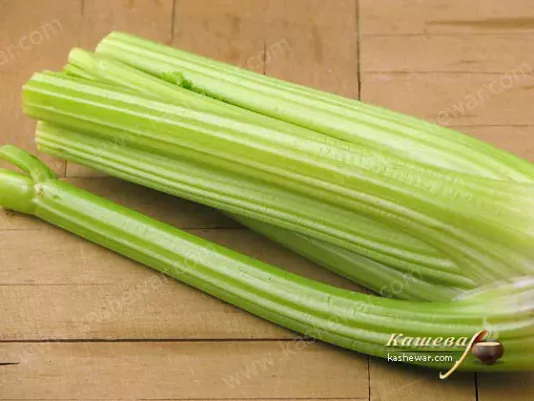Stuffed Pattypan Squash
Stuffed pattypan squash – when you look at pattypan squash, it looks like a flower-vegetable and the first thing that comes to mind is to stuff it with something to preserve this natural beauty.

Celery stalks are a vegetable that should always be in the refrigerator. It not only enhances flavor but also helps balance a dish. Fresh celery has firm, glossy, bright green stalks and a delicate aroma. It’s added to soups, salads, marinades, juices, sauces, and even desserts – in small amounts for contrast. Through years of cooking, I’ve learned to sense the moment when celery doesn’t overpower the flavor but only highlights it. This art requires attention: a single extra stalk can upset the harmony of a dish. It’s also important to store it properly – in a damp towel, in a cool place, so the stalks stay juicy. That way, it keeps its shape and aroma for up to a week. This freshness is what makes celery indispensable in professional kitchens.
Over years of cooking, I’ve learned that the flavor of a dish begins at the market. I never buy celery with limp or spotted stalks – they’ve already lost much of their aroma. Ideal celery has firm, juicy stalks that snap when gently bent. The color should be rich green or with a hint of lime. If you see dry fibers on the cut, the celery is old. I always check the smell: the fresh aroma should be grassy, without bitterness. I also inspect the root end – it should be clean, with no signs of rot or moisture. For salads, I choose thin, tender stalks, and for braising, thicker ones since they hold their shape better. I never buy celery stored next to strong-smelling vegetables because it absorbs odors quickly. The best time to buy is in season – from late summer to mid-autumn – when the aroma is most pronounced and the texture crisp. If I plan to store it longer, I wrap the stalks in damp paper and keep them in the fridge away from ethylene-producing fruits. Such simple care preserves the vegetable’s freshness and flavor for a week.
Before cooking, I always rinse celery thoroughly under cool running water. Its grooves often trap small grains of sand or soil, so I take time to clean each stalk individually. For salads, I remove the tough fibers – using a knife or peeler, starting from the base. This ensures a tender texture without excess toughness. If celery has too strong a flavor, I soak the stalks for a few minutes in cold water with a few drops of lemon juice – this softens the taste. I cut the vegetable depending on its purpose: thin half-moons for fresh salads, larger pieces for broths and casseroles. Over years in the kitchen, I’ve noticed that the right cut significantly affects the final result: finely chopped celery quickly loses aroma during heat treatment. To preserve its full flavor, I add it near the end of cooking. These are small details, but they define a chef’s professionalism.
Celery is easy to ruin with too much heat. It’s delicate, so I always work over moderate flame. For sautéing, I use a heavy-bottomed pan and add a small amount of oil. Over medium heat, celery softens without losing color. For a deeper flavor, I caramelize it with onions – the vegetables should turn translucent, not golden. For soups, I cook celery no longer than 15-20 minutes to retain its aroma and slight bitterness that gives depth. I roast it at 180°C (356°F), especially for vegetable sides. At this temperature, the stalks develop a sweet note and become tender but hold their shape. For braising, I use low heat and a bit of broth – then the celery opens up softly without turning to mush. It’s important not to cover it tightly: excess moisture spoils the texture. I’ve perfected these nuances over the years because even the simplest dish demands attention to detail.
Celery is incredibly versatile. In cold dishes, I love combining it with apples, walnuts, and soft cheese – it makes a light, refreshing salad. In warm dishes, the stalks pair beautifully with carrots, onions, chicken, or lentils. Over years of practice, I’ve learned to sense balance: celery shouldn’t dominate but support. In meat sauces, I use finely chopped celery as a flavor base – it adds natural savoriness. With lemon and garlic, the vegetable reveals new depth, especially in creamy sauces. I pair it carefully with herbs: basil or oregano can overpower its aroma, so I often use parsley or thyme instead. In desserts, celery is rare, but in small amounts, it works wonderfully with citrus and mint, adding unexpected freshness. I’ve realized that celery isn’t just a vegetable – it’s a tool for creating complex aromatic compositions when treated with respect.
The most common mistake is overcooking. Many leave celery over high heat, losing its crunch and aroma. From experience, I’ve learned to always taste it during cooking – it should be tender but still slightly firm. Another mistake is storing it near fruits that emit ethylene, which accelerates wilting. I keep celery in a separate container with a damp towel – it stays fresh longer. Pairing mistakes are also common: too much salt or vinegar destroys the vegetable’s natural savory note. Never cut celery too early – the cut darkens quickly, and the aroma fades. Another tip from experience: never add celery to cold oil – it will absorb fat and become heavy. Wait until the oil is gently sizzling. I always tell my students: quality control isn’t about strictness but about care. When you treat every stalk with attention, the dish rewards you with pure flavor and natural beauty.